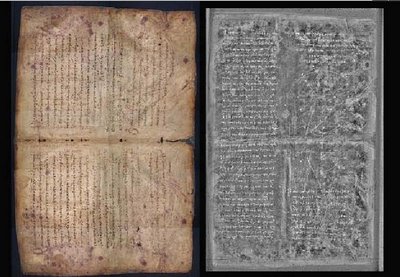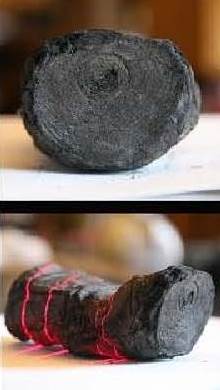Alexandra Alter reports in today’s Wall Street Journal on global  projects to digitize and make available the world’s ancient manuscripts that have long been unreadable. Click here to read her article: The Next Age of Discovery. (Wall Street Journal, 8 May 2009).
projects to digitize and make available the world’s ancient manuscripts that have long been unreadable. Click here to read her article: The Next Age of Discovery. (Wall Street Journal, 8 May 2009).
“Archivists at the Walters Art Museum in Baltimore used multispectral imaging to read this palimpsest, or text that had been scraped off and written over by a later scribe. The text had been covered up by a 13th-century monk who scraped the parchment with pumice and used the pages to write a prayer book. Multispectral imaging revealed a hidden mathematical treatise by the Greek mathematician Archimedes (above).”
 “Brent Seales, a computer scientist at the University of Kentucky, is pioneering the “virtual unrolling” technique for fragile or burned scrolls. Prof. Seales plans to test 3-D X-ray scanning on two papyrus scrolls from Pompeii that were charred by volcanic ash in 79 A.D.”
“Brent Seales, a computer scientist at the University of Kentucky, is pioneering the “virtual unrolling” technique for fragile or burned scrolls. Prof. Seales plans to test 3-D X-ray scanning on two papyrus scrolls from Pompeii that were charred by volcanic ash in 79 A.D.”
“Multispectral imaging — originally developed by NASA to capture satellite images through clouds — has proved remarkably effective on everything from ancient papyrus scrolls to medieval manuscripts that were scraped off and written over when scribes recycled parchment pages. Using the technique, which captures high-resolution images in different light wavelengths, scholars can see details invisible to the naked eye: For example, infrared light highlights ink containing carbon from crushed charcoal, while ultraviolet light picks up ink containing iron.”

If you find this exciting you should read “Archimedes Codex” by Netz and Noel. Then go to the Walters Art Museum in Baltimore and see the Codex they worked on for about 10 years
Douglas Burnett
Satellite Beach
FL
That’s good. I want to read that book.
Tom